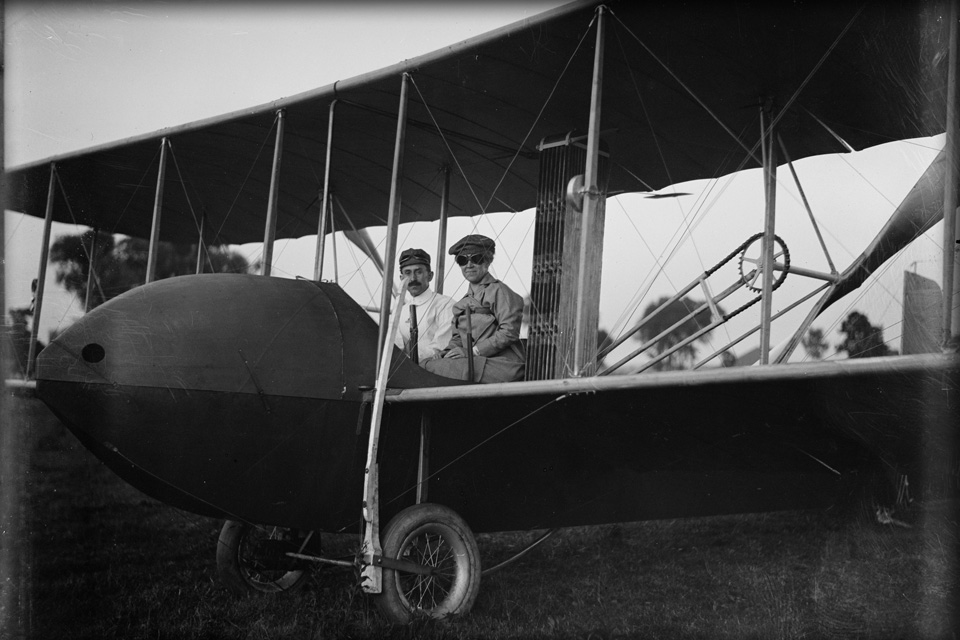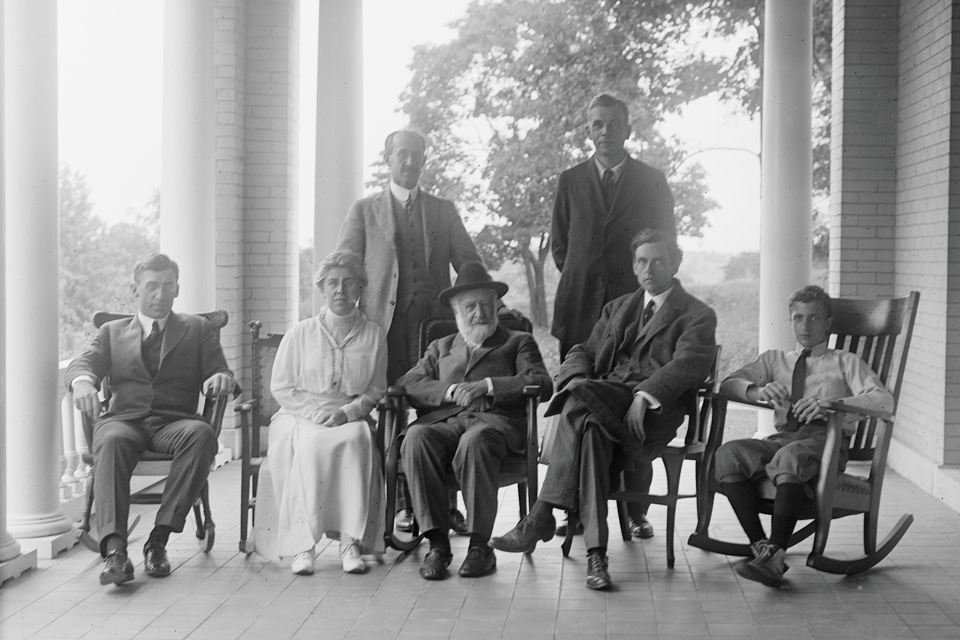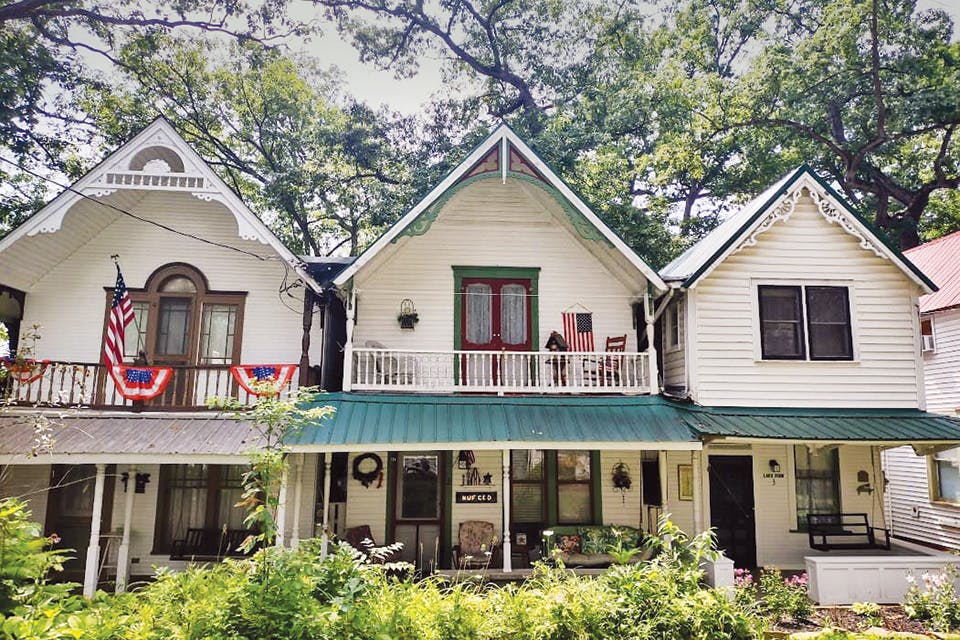How the Wright Brothers’ Sister Shaped History
Katharine Wright was her famous brothers’ not-so-silent partner, aiding her siblings Orville and Wilbur in their quest to get their dreams of mechanical flight off the ground.
July/August 2024
BY Damaine Vonada | Katharine and Wilbur Wright seated in the Wright Model A Flyer, Photo courtesy of Wright State University Libraries’ Special Collections and Archives
July/August 2024
BY Damaine Vonada | Katharine and Wilbur Wright seated in the Wright Model A Flyer, Photo courtesy of Wright State University Libraries’ Special Collections and Archives
After Charles Lindbergh made the first nonstop solo flight from New York to Paris in 1927, he went to Dayton to visit Orville Wright. It was supposed to be a private meeting between the world’s latest aviation hero and the world’s first aviator, but word leaked out and droves of Daytonians descended on Hawthorn Hill, Orville’s mansion in suburban Oakwood. They trampled flowerbeds and climbed trees until Orville and “Lucky Lindy” mollified the unruly crowd by stepping onto a second-story balcony above the mansion’s entrance.
Orville and his brother Wilbur, of course, invented the airplane in 1903, and Hawthorn Hill was the success home they had planned with their sister Katharine. Like her brothers, Katharine was unmarried, but she was hardly the stereotype of a bland and needy spinster. She, in fact, was the Wright Brothers’ most steadfast supporter in their quest to create the first machine capable of controlled, powered flight. As their indefatigable helpmate, confidant, counselor and cheerleader, she nursed Orville and Wilbur through illnesses and injuries, ran their family’s household and supervised their bicycle shop in Dayton during their flying experiments on the windblown sands of Kitty Hawk, North Carolina.
Katharine had convinced her brothers that as men of consequence, they needed a residence suited to their elevated means and social status, and the balcony where Orville and Lindbergh made their appearance was outside the bedroom she’d chosen for herself. It was Hawthorn Hill’s largest bedroom, had the prettiest window and sat at the center of the Colonial Revival mansion’s front facade. The stately symmetry that characterizes Colonial Revival architecture probably appealed to Orville and Wilbur, who as bicycle mechanics and builders recognized that maintaining balance was crucial to solving the age-old mystery of manned flight. And Katharine, the unfaltering fulcrum on whom the brothers relied for equilibrium in their lives, looked forward to putting her own touch on the 34-room manse.
“The new house seems to be well on the way finally,” she wrote to a friend in 1911. “We have quite unexpectedly agreed perfectly on our style of exterior. The interior is ‘up to me.’”
Katharine was born in Dayton on Aug. 19, 1874, three years to the day after Orville. She was the youngest child and only surviving daughter of Milton Wright, a bishop in the Church of the United Brethren, and his wife Susan, who was good at math and mechanically skilled. The couple’s first three offspring, Reuchlin, Lorin and Wilbur were born, respectively, in 1861, 1862 and 1867 in Indiana while the bishop was an itinerant preacher. In 1869, he moved to Dayton to edit the church’s national newspaper, and Orville was born there two years later.
Although their small clapboard house on Dayton’s west side lacked electricity and indoor plumbing, it had two libraries. The one in the bishop’s bedroom consisted primarily of theological tomes. The other in the sitting room contained books by Virgil, Plutarch, Gibbon, Dickens, Darwin and two sets of encyclopedias. Sir Walter Scott was Katharine’s favorite author, and for her birthday in 1900, Orville and Wilbur gave her a bust of the Romantic poet and novelist.

Katharine Wright donned a leather jacket, cap and goggles aboard the Wright Model HS airplane with her brother Orville in 1915. (photo courtesy of the Library of Congress)
The Wrights were a tight-knit family, but because Wilbur, Orville and Katharine were still living at home when Susan died of tuberculosis in 1889, the bond between them grew especially strong. Though just shy of 15 years old, Katharine dutifully endeavored to fill the void left by their mother, making herself useful by keeping house and looking after her father and her brothers.
In contrast to Wilbur, who often retreated into his own thoughts, and Orville, who was notoriously shy in public, Katharine was gregarious and loved to converse with people. Strong-willed and opinionated, she spoke her mind and stood her ground in their predominately male household.
In keeping with his belief that women had a right to an education and a profession, the bishop sent Katharine to Oberlin in 1893 to become a teacher. The college had pioneered American coeducation, and Katharine thrived in its progressive environment, getting good grades in Greek and Latin and forming lifelong friendships. In her 1898 graduation portrait, Katharine’s high-collared dress was properly Victorian, but behind her pince-nez spectacles, her eyes confidently looked toward the future.
Returning to Dayton, Katharine resumed her role of running the Wright household, but after obtaining a full-time position teaching high school Latin, she persuaded her father to hire a neighborhood girl to do the housework. Although they doted on Lorin’s four children, Wilbur, Orville and Katharine were disinterested in having their own families. They were content with each other’s company and at least tacitly agreed to remain a singular triad bound by blood and loyalty.
While Katharine commenced her career, Orville and Wilbur concentrated on the possibility of mechanical flight. Wilbur contacted the Smithsonian Institution requesting aeronautical information to “avail myself of all that is already known” and approached eminent engineer Octave Chanute for advice about a double-wing glider he and Orville built at their West Third Street bicycle shop. Though Katharine was younger, she acted as the consummate big sister during their efforts to get humankind off the ground.
Katharine was present when Wilbur twisted a bicycle inner tube box to show Orville his breakthrough idea for warping aircraft wings to imitate birds’ wings. When the brothers made their first trip to Kitty Hawk to test their glider, she lent Wilbur her trunk and packed food. While they were gone, she informed Orville that she’d fired the fellow he put in charge of the bicycle shop. In 1901, Katharine badgered Wilbur into accepting Chanute’s invitation to address the Western Society of Engineers in Chicago, then appropriated clothes from Orville to ensure he looked “swell.”
--katharine-and-wilbur-wright--1909_library-of-congress.jpg?sfvrsn=64d1b938_7)
Katharine Wright was her brother’s not-so-silent partner, aiding her siblings Orville and Wilbur in their quest to get their dreams of mechanical flight off the ground. (photo courtesy of Library of Congress)
Before leaving on their 1902 Kitty Hawk trip, Orville and Wilbur worked at home on fabric wings. “Will spins the sewing machine around by the hour while Orv squats around marking the places to sew,” Katharine reported to their father. “There is no place in the house to live, but I’ll be lonesome enough by this time next week and wish that I could have some of this racket around.”
After developing and testing the first practical airplane — the Wright Flyer III — at Dayton’s Huffman Prairie in 1905, the brothers focused on selling their invention. They secured contracts with both French businessmen and the U.S. Army, and in 1908, Wilbur went to Le Mans, France, while Orville ventured to Fort Myer, Virginia, to give flying demonstrations. On Sept. 17 of that year, Orville was seriously injured in an airplane crash. Katharine took a leave of absence from teaching and spent weeks at the Fort Myer hospital ensuring he got the best care.
Katharine soon abandoned her career to assist her brothers. Wilbur, on whom the French continually showered accolades and awards, suggested she and their recuperating brother join him in France and asked Katharine to be their social manager. In January 1909, she and Orville boarded an ocean liner in New York. For Katharine, it was the beginning of a glorious adventure. She stayed at luxury hotels; met kings, aristocrats, leading politicians and business titans; and was photographed and covered by the international press wherever she went.
With her vivacious personality and the foresight to take French lessons, Katharine seemed to charm everyone and became as famous as her brothers. In April, a feature titled, “The American Girl Whom All Europe Is Watching” appeared in The World Magazine. Although the writer misspelled her name, the article declared, “The masters of the aeroplane, those two clever and intrepid Americans who have moved about Europe under the spotlight of extraordinary publicity, have a silent partner. She is Katherine Wright, sister of Orville and Wilbur Wright.”
In 1911, Katharine and her brothers sent a joint Christmas card expressing feelings of goodwill toward friends old and new. It was their last Christmas together, as Wilbur would die of typhoid fever at home on May 30, 1912. After Wilbur’s burial in the family plot in Dayton’s Woodland Cemetery, the bishop wrote in his diary, “Probably Orville and Katharine felt his loss the most. They say little.”
After Wilbur’s death, Orville’s enthusiasm for aviation waned, and he leaned on Katharine, who encouraged him to proceed with their plans for Hawthorn Hill. They broke ground in August 1912. A year and a half later, Katherine, Orville and their aging father moved in, and the bedroom once earmarked for Wilbur became a guestroom.

Pliny Williamson, Katharine Wright, Orville Wright, Bishop Milton Wright, John R. McMahon, Earl N. Findley and Horace Wright pose for a photo on the porch of Hawthorn Hill in 1915. (photo courtesy of the Library of Congress)
When Katharine and Orville went to Grand Rapids, Michigan, to purchase Hawthorne Hill’s furniture, she wanted the dining room to have the best and prettiest pieces. Anticipating holiday dinners with their extended family as well as the need to host visiting dignitaries, Katharine splurged on its mahogany, Chippendale-style table, chairs and sideboard. As usual, Katharine was right, for Hawthorn Hill’s guests would include Henry Ford, Thomas Edison, Alexander Graham Bell and Franklin D. Roosevelt.
When Lindbergh arrived, however, Katharine was not at Hawthorn Hill. The previous November, at age 52, she had eloped with Henry Haskell, an old college friend, Kansas City newspaper editor and fellow member of Oberlin’s board of trustees. Feeling abandoned and betrayed, Orville refused to speak to her again.
After Katharine contracted pneumonia in 1929, Orville relented and went to see her in Kansas City shortly before she died. Having denied Katharine a wedding at Hawthorn Hill, Orville held her funeral there. She was buried beside Wilbur, and in tribute to Katharine’s helping her brothers change the world, airplanes from Wright Field (the forerunner of Wright-Patterson Air Force Base) dropped flowers on her grave.
Today, the Wright brothers’ bicycle shop is part of the Dayton Aviation Heritage National Historical Park, and the Wright Flyer III is proudly preserved at Carillon Historical Park in Dayton. While they are testaments to the brothers’ ingenuity and persistence, the best monument to Katharine is Hawthorn Hill. The entire house reflects her taste and sensibilities, and because Dayton History now offers tours, visitors can learn her story, see furnishings she selected and appreciate the lovely and dignified stage she set for Orville’s comfort in retirement.
Orville lived at Hawthorn Hill until his own death in 1948, when he joined Orville and Katharine in Woodland Cemetery. Still a triad, they have identical headstones with Orville on one side of Katharine and Wilbur on the other. In death as in life, the remarkable woman is forever at the center of things.
Related Articles

Epworth Park Is One of Ohio’s Last Remaining Chautauqua Communities
This tranquil spot in Bethesda is filled with historic cottages and has a long legacy as a summertime retreat. READ MORE >>
.jpg?sfvrsn=8999b638_5&w=960&auto=compress%2cformat)
Midcentury Barware Show Hosted by Gay Fad Studios Returns to Lancaster
Bottoms Up features gorgeous glassware, entertainment, special presentations and much more over its four-day run. READ MORE >>

The Fairport Harbor Marine Museum and Lighthouse Shines a Light on Great Lakes History
This museum along the Lake Erie shore offers an informative and immersive look at maritime history. READ MORE >>



